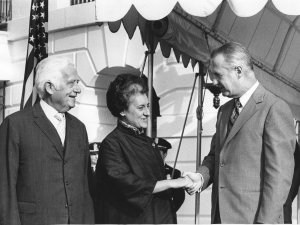Ed Karrens: Air travel is probably safer now than it ever has been, what with new designs and equipment, flight safety controls and pilot training. But the drama and fury of an airplane crash with the usual high death rate still make it a story of major proportions, and so it was during a thunderstorm on June 24th in New York City as a Eastern Airlines' Boeing 727 approached Kennedy Airport ï?½
Moe Friedman: "I was coming along Rockaway Parkway, and about I'd say approximately 100 or 150 yards in front of me I saw this big flash of fire like the ... atomic bomb goes off right across the highway! It went up in the air I'd say about five, six hundred feet! That's what scared me! I jammed my brakes and stopped and wondered, and the first thing I did is I swung right around and went the other way."
Ed Karrens: Truck driver Moe Friedman was an eyewitness to the crash which miraculously had 10 survivors; but 113 died, making it the worst air disaster involving a single plane in the continental United States.
For Julia and Joseph Quinlan, 1975 was a momentous and trying year. In their quiet suburban Morristown, New Jersey home they learned their daughter, Karen Ann, would probably never recover from a coma that had already lasted for two months. Artificial means were being used to keep her alive. Doctors said even if she did recover, irreparable brain damage would prohibit a useful or a normal life. Karen Ann was alive, but few could call it living.
So the Quinlans made a request to their doctor: pull the plug of the equipment keeping Karen alive and let her die. The decision was put into the hands of a judge, who after hearing testimony said, no, Karen must live. The decision was appealed by the Quinlans, and Mrs. Quinlan said the request is one they would make again.
The question of life or death was not nearly as complicated for a Plantation, Florida man. He knows he's very much alive. But according to the computer and the Florida Medicare office, he was dead. Therefore, all payments for Herman Cosman's medical treatment would stop ï?½
Herman Cosman: "We kept complaining, giving them all our case numbers. Everything was being recorded, more and more letters were being written, and everything wound up with a big zero. According to their records, there should be no reason for payments not being made; but it wound up that we never got paid, doctors weren't being paid, nobody. All they kept telling us, that somehow or other I'm dead. This is their answer. I'm not entitled to anything, I'm dead."
Ed Karrens: Well, the mess did get straightened out and Mr. Cosman assured Medicare he was alive, and Medicare assured Mr. Cosman he would still get medical help and it would be paid for by them.
(00:14:58)
Another story with a happy ending involves a duck. Warren Stovall of Slidell, Louisiana brought back a drake mallard from a hunting trip. His taxidermist told him to wrap the duck in tinfoil and put it in the freezer until the next day, when the animal stuffer could pick it up. And that's just what Mr. Stovall did. But later that day when he opened the freezer door ï?½ well, let's let Mr. Stovall tell the story ï?½
Warren Stovall: "He had kicked himself out of the bag and ï?½ and out of the tinfoil, which is a pretty amazing feat for anybody, especially a duck, and he was just sitting in the freezer and I had droppings on the freezer floor where he had just been sitting there, and soon as I opened the freezer door he just flew out at me and I caught him in midair."
Ed Karrens: And for that duck, well, let's hope 1976 will be a less traumatic year for him.











